“In modern sheet metal fabrication, the demand for lightweight metal parts has been on the rise. This way sheet metal forming is presumed to be efficient, and economical, and produces lightweight components to fulfill modern manufacturing requirements.”
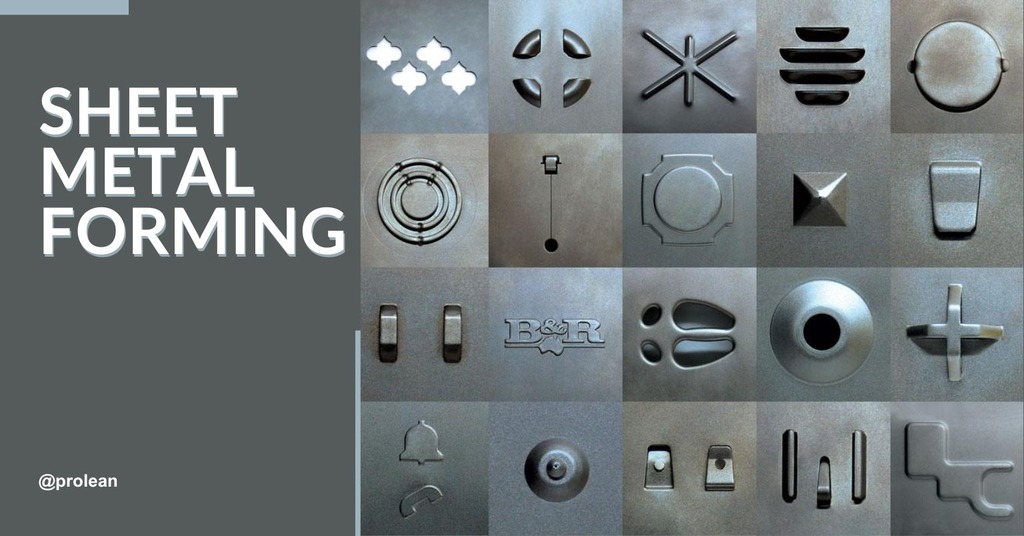
Sheet metal forming is a flexible metal deformation process to shape thin-level metal sheets into desired shapes. The process is relatively cost-effective and ideal for large parts volume. It utilizes multiple approaches such as bending, hydroforming, stretching, punching, and deep drawing to create sophisticated parts with high precision.
From soda cans to aircraft components, sheet metal forming is integral in part manufacturing. Moreover, it forms lightweight yet strong components for various automotive, aerospace, and electrical industries.
Keep on reading, because this article highlights the technical thought on sheet metal forming along with its process, and industrial applications. Alongside, it entails the key benefits, drawbacks, and much more.
What is Sheet Metal Forming?

Sheet Metal Forming
Sheet metal forming, as the name implies, is a twinning process to fabricate thin sheets of metals, or coils for lightweight part manufacturing. The resulting parts from sheet metal forming are relatively high in strength and malleability. Comparatively sheet metal forming is a more cost-effective process than other conventional sheet metal processes.
Various metals can be processed through sheet metal forming such as aluminum, copper, brass, and steel. Moreover, the process can form parts from a few hundred grams to certain tons in minimal turnaround. That’s the reason, it is also exemplified as rapid sheet metal fabrication. The optimal thickness of metal sheets, thin leafs or coils to use for the sheet metal forming process is up to 0.6 mm to 6.43mm.
Try Prolean Now!
Working Mechanism of Sheet Metal Forming
Sheet metal forming accommodates various processes including; bending, spinning, drawing, and stretching. The parts or products are usually formed by pressing a metal sheet between the die and the tool. Here’s is simple breakdown of the sheet metal forming process;
- Firstly, a desired metal sheet is cut out from the stock available in inventory for individual blanks. The commonest metals used for this process are aluminum, steel, copper, and their alloys. The optimal thickness of the sheet varies from metal to metal. In most cases, the thickness of the sheet used for the curing process is up to 6mm.
- Then comes the setup. The desired shape blank is placed in forming machines between the tools.
- After all, a force is applied through an electronically controlled CNC punch. As a result, form the metal into the desired shape.
- One of the key benefits is that you can shape multiple blanks at one time. It means the process is highly economical when there is a need to produce parts in bulk form.
Difference between Hot & Cold Metal Forming
Both of these processes are interchangeably used with different sets of conditions and parameters. Let’s figure out their differences on a deeper level.
Table: Hot vs. cold metal forming
| Parameters | Hot Metal Forming | Cold Metal Forming |
| Process | The process is carried out at elevated temperatures, typically above recrystallization temperatures (1100 to 1300 °C). | Performed below recrystallization temperatures (600 to 950 °C). |
| Forming speed | Faster forming speed due to reduced resistance and increased ductility. | Slower forming speed due to increased material thickness and resistance. |
| Equipment | It requires specialized equipment, like furnaces that can bear high temperatures. | Standard equipment is used such as presses, rolls, and dies suitable for room temperature operations. |
| Applications | It is commonly used for forging, extrusion, and hot rolling processes. | Utilized for cold rolling, cold drawing, and metal stamping processes. |
| Material thickness | Suitable for thick sections due to reduced forming forces. | Suitable for thin sections due to higher forming forces. |
| Cost | Generally higher cost due to high intense thermal and specialized equipment requirements. | Lower cost due to utilization of standard equipment. |
Common Techniques For Sheet Metal Forming Processes
Sheet metal forming accommodates various popular processes for forming sheets into desired shapes. These are;
- Curling
- Bending
- Ironing
- Laser Cutting
- Hydroforming
- Punching
Curling

Metal Sheet Curling
Curling, as the name indicates, is a metal-forming process used to add hollow or circular rolls in sheet metal. The primary objective of curling is to make metal surfaces burr free and durable. In simple terms, it helps to deburr the edges produced during the sheet metal forming process. The compatibility of metal depends upon the ductility, and formability properties. In the process, metal sheets are placed in standard rolling machines that finely apply the punch to bend the sheer into the desired form. Curling is favored to produce edges in panels, trim, or housings. Primarily, curling is used to form fine edges and gives rigidity and safety to the metal parts.
Bending
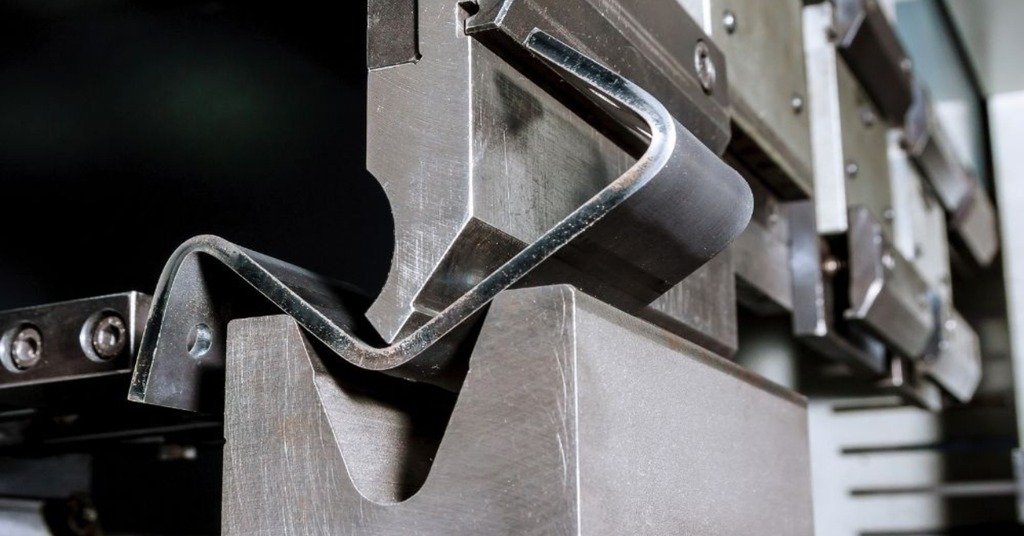
Sheet Metal Bending
Predominantly, bending is used to form curved shapes adjacent to the axis of sheet metals. It typically uses press brakes to create desired shapes and bends. The assembly is adjusted corresponding to the desired shape, and angles. Then, a point press punches the sheet metal, and the respective sheet takes the form of a die placed underneath. Bending is commonly employed to make automotive parts, housings and enclosures, and semiconductor devices. Sheet metal bending is frequently used for its simple tooling requirements. Moreover, it is a relatively cost-effective, and more efficient process than other conventional ones.
Punching
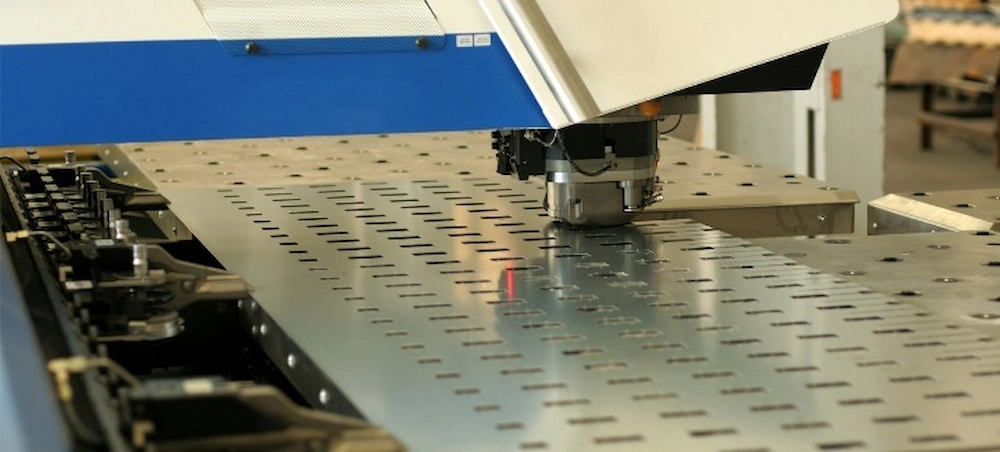
Sheet Metal Punching
Sheet Metal Punching is a reliable forming process to cut to shape contours in sheets with relative ease. Metal sheet is positioned between the die, and punch. The die centrally holds the sheet, and the punch presses along the axis to cut down the metal sheet for desired shapes, and holes. It is massively used for shaping brackets, panels, and enclosures. The high speed, and repeatability, are exceptional aspects of sheet metal punching. Contrary to limiting aspects, it usually requires high tooling for custom manufacturing parts.
Laser Cutting
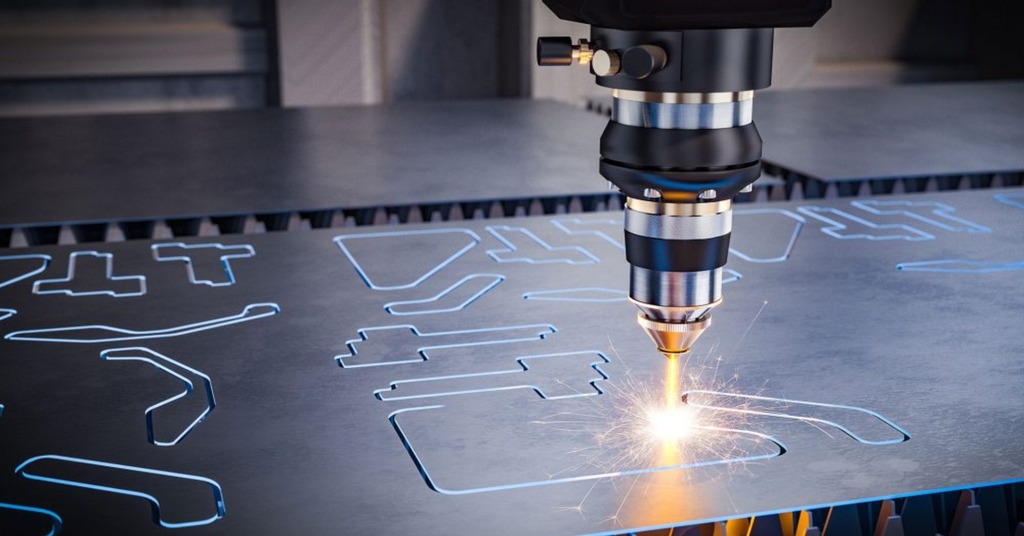
Laser Cutting Sheet Metal
Another versatile technique of the sheet metal forming process is laser cutting. It offers more control because of the integration of computerized numerical control on machining. Laser cutting uses a high-powered laser to cut to shape the required geometry. It is relatively faster and notably more efficient than other forming methods. However, it may require more expertise to make bends in sheets, as it uses a computerized control to shape optimal shape surfaces. One of the major benefits is that laser cutting produces no material waste and often requires minimal post-processing. The only downside of laser cutting is that it requires a higher initial investment.
Hydroforming
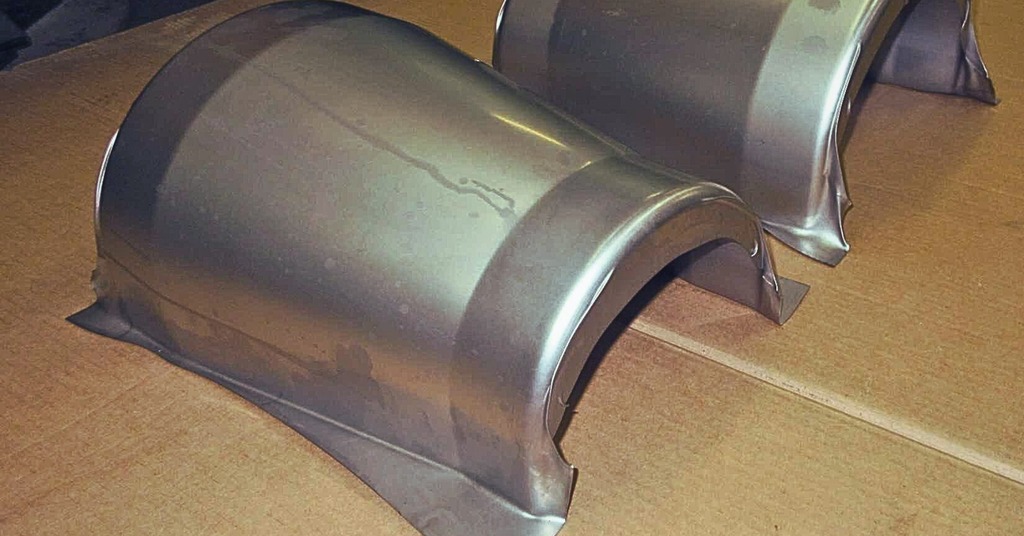
Hydroforming
However, the aforementioned process requires some kind of external mechanical force to create parts. Contrarily, the process of hydroforming is a different process that uses high hydraulic pressure to shape complex design parts. In operation, a sheet of metal is placed over the intended shape die. Then, high-pressure fluid is applied to the corresponding sheet, shaping it into the desired design.
Hydroforming is more versatile as it can machine on various metals such as aluminum, stainless steel, iron, galvanized steel, and copper. Moreover, it is commonly used in aerospace, automotive, medical, and aerospace sectors to shape complex parts such as thin walls, automobile, and aircraft interior, and exterior parts.
Ironing
Ironing, as the term suggests, is used to improve the sheet metal surface finish and thickness uniformity. It uses multiple dies to machine on the metal sheet by punching to reduce the clearance without any deformity, or error. Ironing is used to form beverage cans, for instance, aluminum sheets are used in this aspect.
The bend created through ironing possesses high dimensional accuracy and uniform thickness. Aluminum, steel, and copper are suitable metals for the ironing process due to their high ductility, and formability. Regardless of high accuracy, ironing is limited for fine finishes. Instead, it’s limited to parts that require sharp corners or edges. Moreover, the initial tooling comparatively requires a higher cost than other sheet metal forming processes.
Deep Drawing

Deep Drawing Components
When it comes to shaping hollow and cylindrical shapes, deep drawing is considered a vital option. Metals like aluminum, stainless steel, and brass are commonly used in its process. Similarly to Aluminum Sheet Bending, deep drawing works by placing the metal sheet over dies, and then pressing the sheet by punching to shape desired part geometry. The primary benefit of using deep drawing in your project is that it doesn’t reduce the thickness of sheet metal. Common examples include; containers, automotive parts, beverage cans, automobile parts, and housings. Deep drawing is applicable for metals with high ductility, and formability. For example, aluminum, iron, galvanized steel, and brass are common compatible candidates for sheet metal deep drawing.
Shearing
Shearing in sheet metal
In technical terms, shearing means cutting. Shearing cut down the metal along a curved line. A shearing machine has two sharp blades that slide to tear out the intended metal sheet. The sheet is placed on a die, and the upper blade of the shearing machine pushes the sheet underneath to shape a cut. Shearing is comparably fast, and more economical for large batches of production. Moreover, it produces minimal waste while operating. One limiting aspect associated with this process is, it can cause burr formation and distortion in thicker metal sheets.
Related To: Eight Common Sheet Metal Fabrication Techniques
Try Prolean Now!
Advantages of Sheet Metal Forming
In sheet metal fabrication, sheet metal forming has several benefits. Here are some of the common benefits discussed below;
- Sheet metal forming is an economical process for large-scale production of parts than metal forging, and die casting processes.
- It facilitates a wide range of metal options such as; aluminum, tool steel, and galvanized steel.
- Since sheet metal forming is fast, and produces minimal waste during the process. It is perfect for creating complex prototype sheet metal fabrication.
- Sheet metal forming produces intense, durable, and lightweight parts.
- Sheet metal forming frequently results in smooth, and clean edges with minimal risk of part deformation
- The integration of CNC software designs and control allows precise and accurate cutting, bending, and forming operations.
- There is a diverse range of sheet metal forming processes. You can choose a compatible one from various techniques according to your part specifications.
- Sheet metal forming is ideal for creating small batches of complex shape prototypes. Moreover, the lead time is relatively less than other conventional techniques.
Drawbacks of Sheet Metal Forming
Let’s discuss some demerits of the process.
- Tooling and dies are frequently used in operation. Even though they are fundamentals of sheet metal forming, and often come with higher initial investments.
- Another limiting aspect is that sheet metal forming may be unsuitable for creating extremely complex feature designs.
- Sheet metal forming often produces machined parts with sharp edges. Therefore, to prevent machinists from any damage or injury while working, bevels, and chamfer cuts are used which ultimately impact the high cost of the project. However, it’s an optional part, but it’s quite important to put it on for safety, and quality concerns.
- The sheet metal forming process is passably labor intensive.
- Somehow, thickness limitations are also associated with the sheet metal forming processes.
Compatible Metals For Sheet Metal Forming
There are several standard metals suitable for the sheet metal forming process. The selection criteria usually depend upon material formability and ductility. The common metals Include;
- Aluminum
- Stainless Steel
- Galvanized Steel
- Copper
- Steel
Aluminum Forming
The lightweight, and high-strength nature of aluminum makes it an ideal choice for the sheet metal forming process. Aluminum sheet metal forming parts are widely used in beverages, cold drink cans, housings, enclosure parts of aircraft, and automotive parts.
Stainless Steel Forming
Stainless steel forming is highly favored for several reasons. As, it has extreme thermal, and corrosion resistance abilities. Moreover, its high formability makes it an indispensable alloy for medical, and food industries.
Galvanized Steel
Another durable, and rust-resistant metal. Galvanized steel finds its extensive use in HVAC, refrigeration, and air conditioning systems. It provides ease in fabrication because of its high formability, and strength.
Copper Forming
Copper is the most common metal that everyone knows. It’s among highly malleable, and conductive metals, and has intense forming capability. Therefore, copper is widely used in sheet metal fabrication. It finds its use in power transmission and plumbing fitting applications.
Steel
Steel and its alloys are comparably low cost than other metals. It offers various grades to use in forming applications. Some common examples include; hot rolled steel, cold rolled steel, and tool steel. Among these steel grades, normally, holt-rolled steel is widely adopted due to its high machinability. Moreover, you prioritize this grade for large volumes, when cost is a constant concern in your project. In contrast, cold-rolled steel comparably needs more steps while sheet forming to produce the desired part. Besides this, it found its use in home appliances and aerospace structural components.
Stand by To Avail Quality Sheet Metal Services at ProleanTech
Prolean provides excellent, and affordable services when it comes to sheet metal cutting and forming. Whether you need small-scale prototypes for on-demand manufacturing, we have a great facility to meet your needs. Moreover, we possess a broad spectrum of material options to choose from.
Although, it’s quite difficult to choose from a broader range of sheet metal processes as per your requirements. But don’t get this headache, because our engineers are here to take your job. Our technical team will help you through each step of product development.
With further due contact us now for an obligatory quote today!
Read more:
- Sheet Metal Fabrication for Custom Products: How it Can Bring Your Design To Life
- Maximizing Efficiency in Sheet Metal Punching: Key Tips For Accurate and Precise Results
Try Prolean Now!
Summing Up
Sheet metal forming is a viable solution for fabricating durable metal parts or products. The process has gained significant attention because of the speedy, and economical production of large-volume parts in a shorter period. Moreover, it produces parts with high dimensional stability and minimal requirement for additional processes. However, its diversified operational process can create a problem for machinists to make an appropriate selection. But by knowing material types, and required specifications, you can make an optimal process choice for your project.
Moreover, this article entails useful information on sheet metal forming, its types, and compatible material options. So, you can get most of the insights to bring your project to practicality by known technicalities and issues. To avoid any misconception about the sheet metal process.
FAQs
Q1. Is it an expensive process?
No, relatively, sheet metal forming is a cost-effective, and convenient manufacturing process. It is ideal for large volumes of production parts.
Q2. Which process costs more? Sheet metal stamping or sheet metal fabrication?
Metal fabrication is notably labor-intensive, and usually requires more time for part creation when compared to sheet metal stamping. Therefore, Metal Stamping Costs less, the reason being that it’s a straightforward process that requires minimal operator expertise.
Q3. What are the alternative processes to the sheet metal forming process?
While, injection molding, 3D printing, and injection molding are considered alternatives to sheet metal forming.
Q4. Can sheet metal forming shape complex prototypes?
Yes, metal forming techniques; bending, hydroforming, and deep drawing are used to create complex shape prototype sheet metal fabrication.
Q5. What are the common issues in sheet metal forming?
The most common issues that product manufacturers face during metal forming include; spring back, thinning, bending interference, distortion, and wrinkles.
Resource
Christopher B. Smith, Rajiv S. Mishra, (2014), fundamentals of formability, Sheet metal forming: Retrieved From Science Direct.

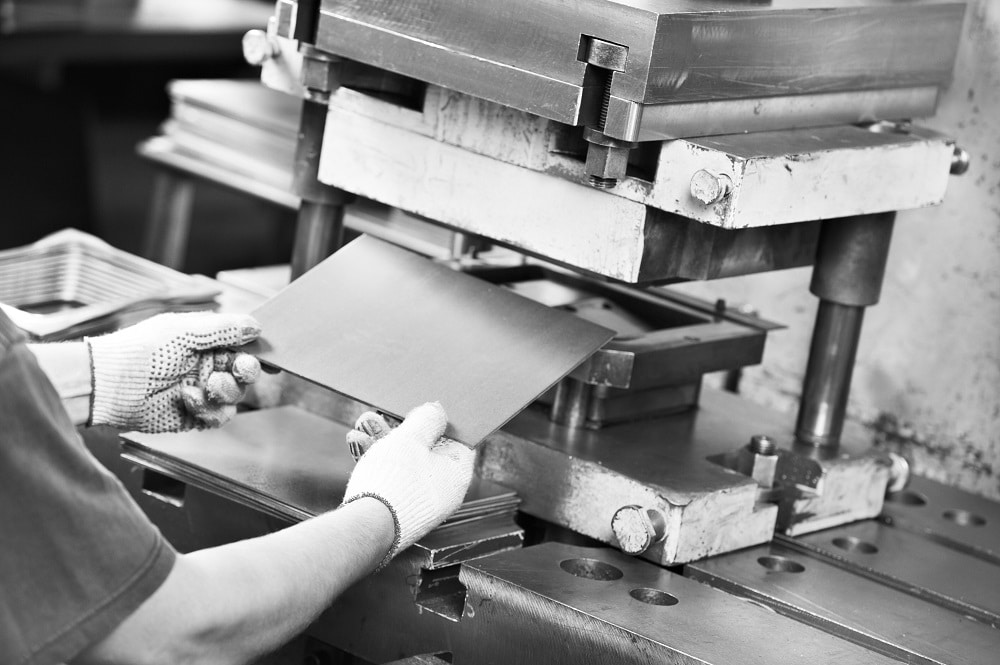
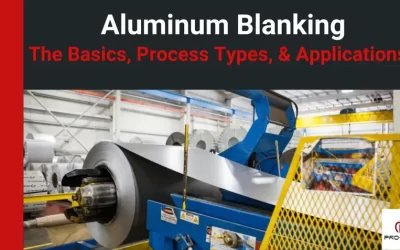
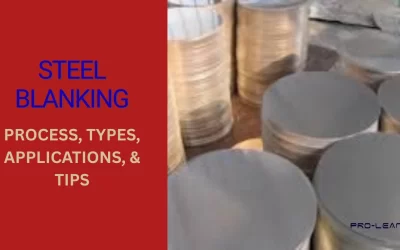
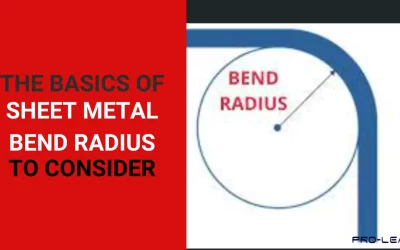
Can you tell which is more cheaper for aluminum parts Cold forming or Hot Forming ?
The cold forming is less costlier than hot metal forming.